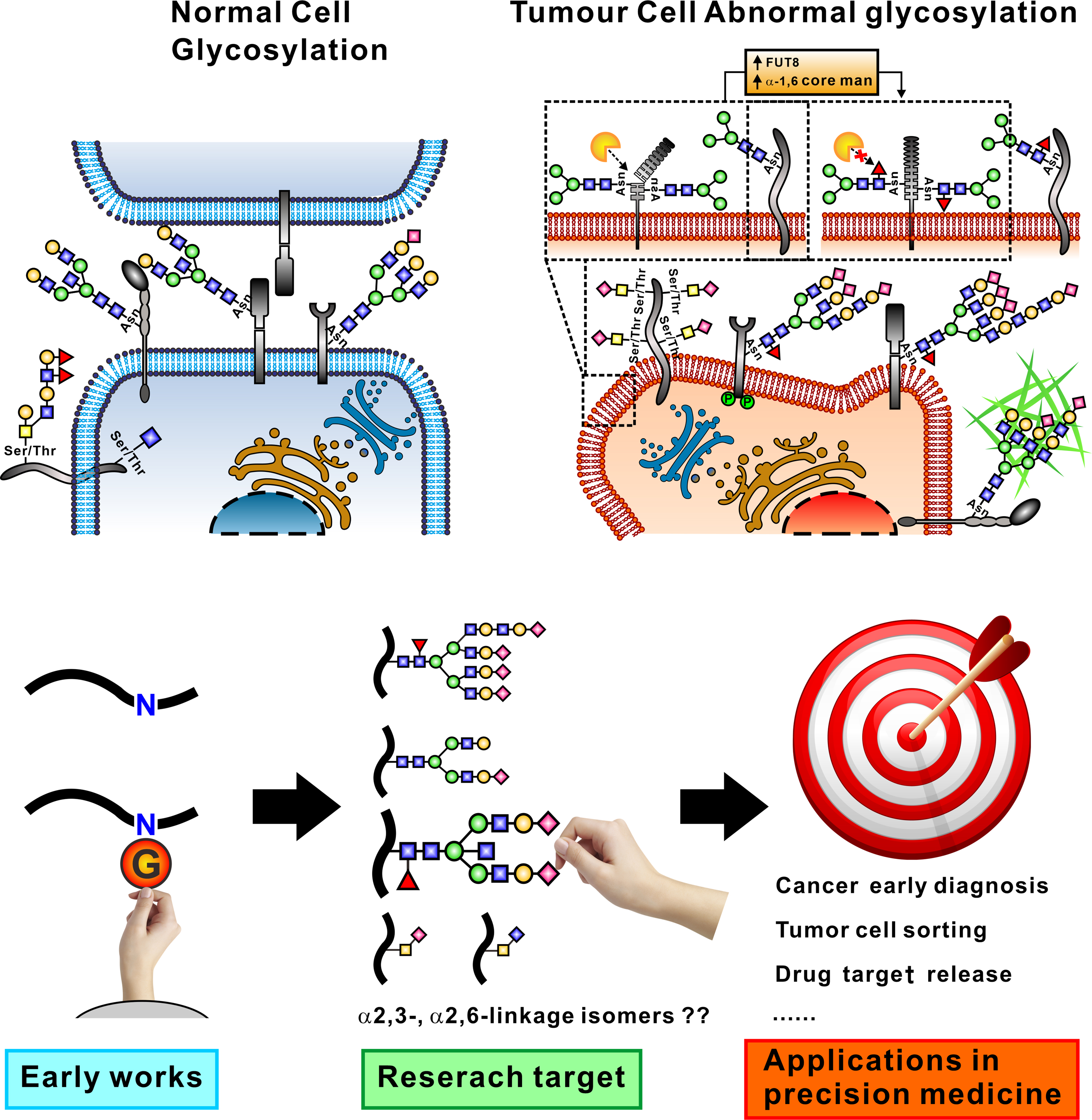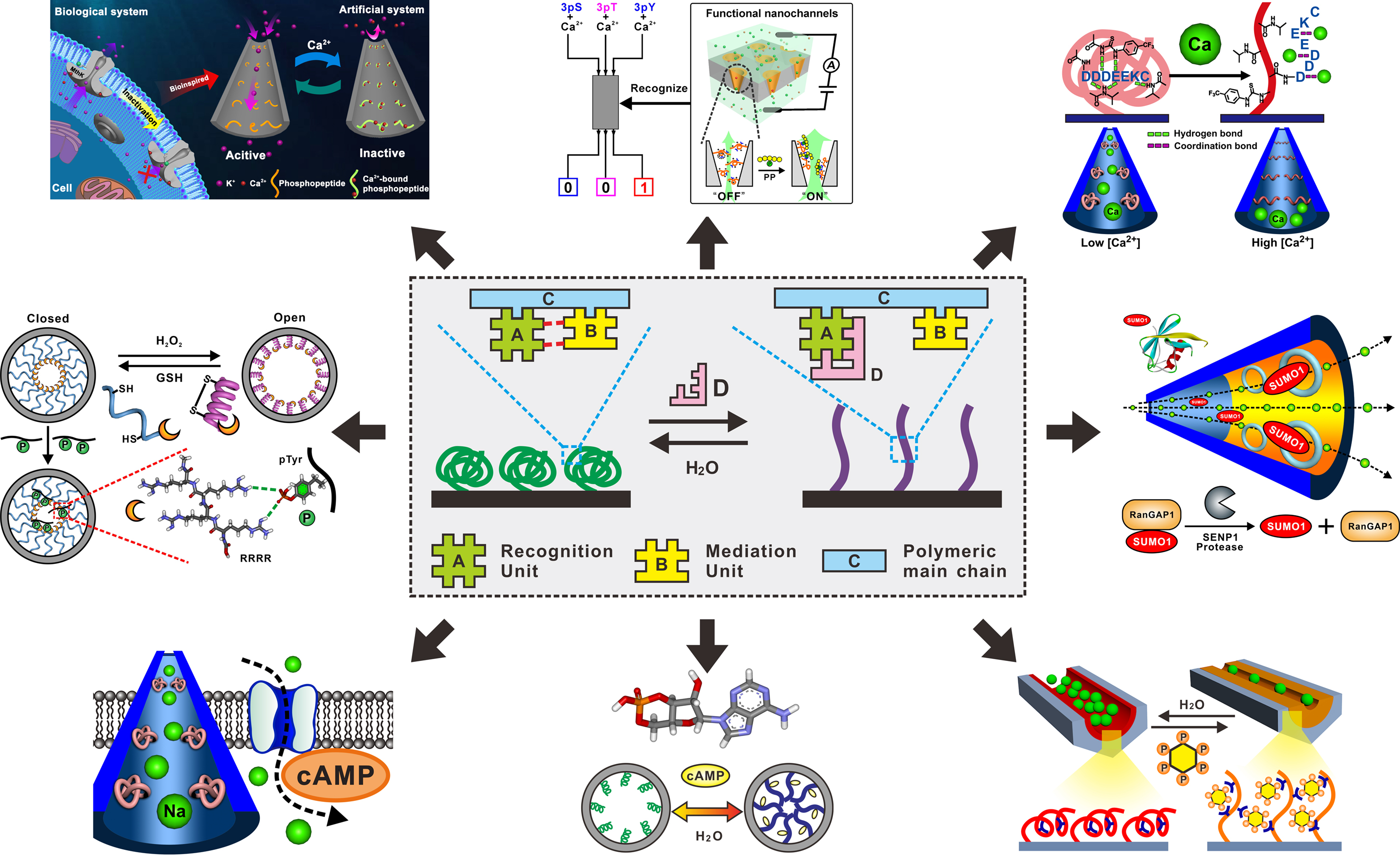- English
1. Precise glycan capture and analysis

Carbohydrates, glycoproteins and glycoconjugates widely exist in living system and play vital roles in numerous biochemical processes. In addition to the well-known roles of glucose as fundamental energy source of living cells and intermediate products of metabolism, glycoprotein has been discovered to participate in most life processes, including protein folding, stability and transport of proteins, mediation of inflammatory response, regulation of leukocyte cell adhesion, control of angiogenesis and blood clotting. Glycosylation is one of the most common and important types of protein post-translational modifications in mammalian cells. Subtle alteration of one monosaccharide in immunoglobulin G (IgG) glycan might remarkably change the glycoproteins’ biological functions. Increasing evidence has proved that altered or abnormal expression of glycans on glycoproteins is closely related to many diseases, such as oncogenesis, cancer transformation and progression. Importantly, more than 50% of cancer biomarkers used in clinical diagnosis are glycoproteins, for examples, alpha-fetoprotein (CA 125) and mucin epitopes (CA15-3). Thus, the exploration and discovery of protein glycosylation has become a new interdisciplinary research of chemistry, biology and biopharmaceuticals.
Glycans contain an abundance of information owing to their complex carbohydrate composition, different branched structures and linkage types, which constitute a mysterious “glycoworld”. However, it is extraordinarily challenging to analyze the mysterious “glycoworld”, which requires the identification of both glycosylation sites and glycan structures simultaneously. To decode the glycoworld, it is highly important to enrich glycopeptides or separate glycans with low abundance from complex biosamples, such as blood, saliva, cerebrospinal fluid, or urine, which strongly requires the development of various glycopeptide or glycoprotein enrichment materials and tools. In addition, the analysis of delicate structures of glycans is more challenging, which strongly relies on the combination of high resolution MS and two-dimensional NMR, sufficient glycan samples with high purity and well trained analysts are needed urgently. We are devoting our efforts to develop various advanced glycan-specific materials and devices to solve this puzzle problem of glycan analysis and decoding. Ref: Qing, et al. Recent Advances in Hydrophilic Interaction Liquid Interaction Chromatography Materials for Glycopeptide Enrichment and Glycan Separation, TrAC Trends in Anal. Chem. 2020, 124, 115570. Enrichment Driven Glycoproteomics: New Materials, New Methods, and Beyond, TrAC Trends in Anal. Chem. 2023, 168, 117290.
2. Nanopore analysis

Nanopore sensors are capable of identifying individual molecules or biomarkers at very low concentrations (nM or uM), with rapid reaction times that often yield results within several minutes, making them well-suited for real-time monitoring applications. In addition, the versatility of the nanopore sensors allows for the simultaneous detection of multiple target molecules, greatly improving the detection efficiency. Their miniaturized design facilitates integration into portable devices, providing the possibility for field detection. Therefore, nanopore biosensors show broad application prospects in the fields of biomedicine, environmental monitoring, and food safety.
Our research group has conducted a series of studies on the chemical modifications and applications of solid nanopores, innovatively integrating biomolecule-responsive polymer with the solid nanopore. Upon stimulation by specific biomolecule, the polymeric chains could undergo sensitive and reversible conformational changes from contraction to relaxation, or vice versa, leading to controllable transition between "closing" to "opening" of the nanopores. This mechanism lead to significant changes in the transmembrane ionic current, enabling accurate detection of calcium ions, cyclic adenosine phosphate, phosphoinositol phosphate, glucose, sialylated glycans, phosphorylpeptides, methylated peptides, ubiquitinoid peptides, as well as dynamic tracking of enzymatic reactions. In the future, we will focus on the development of sensors based on solid-state nanopores or protein nanopores to identify and analyze glycans through the modification of functional groups, finally realizing the glycan sequencing. At the same time, we aim to create nanopore arrays to achieve highly sensitive and high-throughput detection of a variety of disease bio-markers for precision medicine. Ref: Qing, et al. Nanopore: Emerging for Detecting Protein Post-Translational Modifications, TrAC Trends in Anal. Chem. 2024, 173, 117658.
3. Smart enrichment materials for post-translational modification (PTM) proteomics

PTM-proteomics is one of the leading edge and hot research topics in the fields of biology and medicine. Owing to powerful capture capacities of phosphorylated peptide or glycosylated peptide enrichment materials, the research of protein phosphorylation and glycosylation develop rapidly, discovering a series of cellular signal pathways that are closely related to cell apoptosis, tumorigenesis, immune response and neurodegenerative diseases, which provide solid supports for the early diagnosis of disease, effective treatment and target drug development.
However, except for the well-known protein phosphorylation and glycosylation, there are more than three hundred PTM types, including the most typical ones, such as methylation, acetylation, ubiquitination and others. The capture of these PTM-proteins or peptides strongly relies on antibodies, which usually suffer from low enrichment efficiency, high cost, and easier deactivation. The lack of high-efficiency artificial materials severely constrains related research. Therefore, the development of precise enrichment materials, particularly those based on biomolecule-responsive polymers, will have broad application prospects, capable of providing a series of powerful material tools for in-depth biological and medical research. Ref: Qing, et al. New Opportunities and Challenges of Smart Polymers in Post-Translational Modification Proteomics, Adv. Mater. 2017, 29, 1604670; Innovative Chemical Tools to Address Analytical Challenges of Protein Phosphorylation and Glycosylation, Acc. Chem. Res. 2023, 56, 2514-2525.
4. Biomolecule responsive polymers and bio-applications

Life systems strongly rely on biomolecular interactions, such as DNA-protein, antibody-antigen, protein-glycan, protein-drug interactions, to perform various bio-functions, which further modulate a wide variety of cellular behaviors. Precise molecular recognition and highly specific interaction between two biomolecules are the basis and prerequisite for biomolecules performing their bio-functions. Through learning and mimicking the specific biomolecule interactions, and integrating the conformational transition of smart polymer chains, a series of biomolecule-responsive polymers could be developed, which well satisfies the high demands of “Precision Medicine”, also called “Individual Therapy”. Owing to the substantially higher recognition and capture efficiency of the materials, biomolecule-responsive polymers and corresponding devices will find broad applications in bio-separation, bio-analysis, controllable drug release, biochips, protein conformational modulation and tissue engineering. This direction integrates multiple research fields, including smart polymer, host-guest chemistry, micro-/nano-devices, precise measurement, biochemistry, medicine, we anticipate that it would grow up into a hot research topic in the near future. Ref: Qing, et al. Biomolecule-Responsive Polymers and Their Bio-applications. Interdisciplinary Materials, 2024, 10.1002/idm2.12210.
附件【li-et-al-2023-innovative-chemical-tools-to-address-analytical-challenges-of-protein-phosphorylation-and-glycosylation.pdf】
附件【idm212210-正式出版.pdf】







